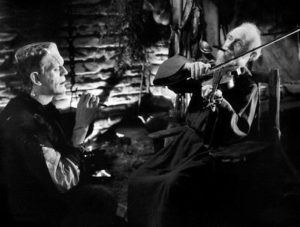Happy All-Hallow’s Month! In anticipation of Halloween — which, let’s face it, we’ve been anticipating since last Halloween — Daily Grindhouse will again be offering daily celebrations of horror movies here on our site. This October’s theme is horror sequels — the good, the bad, the really bad, and the unfairly unappreciated. We’re calling it SCREAMQUELS!
And if you like this feature, please check us out on Patreon for unique reads and deep dives! Just $3 a month gets you everything! All treats, no tricks.
One of my favorite fun facts to tell people about my time at college as an English major is that I once had to read Frankenstein five times over the course of one year, in two different editions, occasionally with multiple essays. Because of this constant need to deep dive, I eventually got intimately familiar with the story and the fairy goth-mother Mary Shelley’s backstory around its creation. The Creature as both terrifying and sympathetic was a balance that fascinated me, but one of the things I missed the most when it came to James Whale’s (basically perfect) 1931 film adaptation was the sequence involving the blind man and his family. The group is integral to both the Creature’s understanding of himself and the world around him. Through them, though he has little direct contact, he learns language and philosophy and what it looks like when people treat each other with love, respect, and kindness. There are, of course, any number of lenses through which to interpret the story of Frankenstein; as a disabled person I am most often interested in the way it handles the ideas of how different kinds of people treat those who look and move and speak differently than them. The Creature’s jerky movements from 1931 could be me at any post-surgery time during which I was relearning how to walk. His desperate search for connection could be any of us at all.
The family that taught the Creature the best parts of the world while he was healing from some of the worst do not make an appearance in the original Whale adaptation, but they do in 1935’s follow up BRIDE OF FRANKENSTEIN. Or, the blind man does, at least. Only this time Whale approaches the interaction from an altogether different angle. One both more sympathetic and more damning than the original text.
Shot and burned by a mob of townsfolk following an unfortunate attempt to save a woman who had been so startled by the Creature’s appearance that she fell and nearly drowned in the lake, the Creature wanders through the woods looking for, if not someone willing to take a moment to understand his gesticulations, at least a place to rest, he stumbles on the blind man’s cottage. Lured by the light in the window and the peaceful sounds of music in the air, the Creature inches cautiously closer. The blind man hears his approach and stops, wandering outside briefly to try and determine the source. Contrary to the novel, wherein the Creature is so afraid of being shunned by the family within that he hides in a nearby shed and watches them from a distance, doing small kindnesses along the way, in BRIDE the blind man lives alone. He has, in fact, been praying desperately for a friend to come along and keep him company. In fact, in the film the blind man is the one who teaches the Creature how to speak. He teaches him how to smoke cigars and drink wine and entertains him with music. The blind man is, outside of the little girl from the 1931 film, the first person to show the Creature any kindness at all.

It is easy to assume this open heartedness is due to a kinship of struggle. The blind man cannot see, the Creature cannot talk, they are equally at a distance from ordinary society. But the blind man also makes it a point to offer his house as rest for any weary traveler in need; it is sheer luck for them both that the Creature found the cottage—though the kind of luck it is turns out to be a bit of a mixed bag.
The decision to have the blind man on his own in BRIDE is an interesting one. On the one hand, he lives outside of town, and we are led to believe he does not have a lot of interaction with anyone besides the occasional lost traveler, which says a little something about the dynamics of the town itself. No one, it seems, comes to check on him, after all. On the other, he does not seem to need anyone in any material sense. That is, his longing for company is not because he needs help with anything; he’s simply lonely. He can navigate his house and its surrounding area with little to no assistance even from his own cane. His life may be a simple one, but it is by all appearances also one in which he has found meaning and purpose, offering it out as he does to anyone who needs rest, even if only for a moment. Even if they are otherwise shunned by the world. Even if, in the eyes of everyone else, they are a monster.
How long the Creature spends at the blind man’s house is unclear. No distinct passage of time is necessarily marked. It could be hours, it could be days or weeks, but it is at any rate enough time for the two of them to form a bond and for the Creature to learn enough language to carry him through the rest of the film. No matter how much time you choose to believe has passed, the intrusion upon their peace is no less jarring.
Some travelers, lost and in search of the path back to the road, poke their heads into the old man’s house and ask for the way. As he has always done, he invites them in to rest for a bit before continuing their journey. They accept, but as soon as they lay eyes on the Creature everything comes crashing down. In fear, they attempt to shoot the Creature—while still in the old man’s house which, ‘30s or not, just seems bad manners—and the blind man attempts to stop them, stepping in between the two men and his newfound friend. He is, after all, the only person who has taken any time at all to get to know the Creature beyond his physical appearance and as such is the only one left who knows he does not mean any harm unless threatened.

The thing about pressurized interactions between able-bodied and disabled people, though, is that more often than not—whether you’re able to independently function or not—if the able-bodied person fears the disabled person might be in danger there are one of three ways it can go: ignoring the situation entirely, becoming an aggressor toward the disabled person and thus adding to the danger, or inserting themselves into a kind of savior role where they will do anything to get the disabled person away from the threat, even if it may cause the disabled person harm. There are, of course, varying degrees of good and bad intention to this last option in particular. In my own experience, able-bodied people trying to “save” me from situations or environments that have looked more like a danger than they actually were were almost always coming from a good-hearted though occasionally misguided place. One of the hardest things for able-bodied people who are (usually) trying to be helpful to understand is that disabled bodies work in ways theirs don’t. You cannot simply pull a disabled person along in the same way you could an able body. An able-bodied person would eventually be able to catch their footing and run alongside you if you lift and drag them by the arms. Doing the same thing to a disabled person does little more than cause them injury and humiliation. Similarly, forcibly removing a disabled person from an environment they are comfortable in—particularly one in which they live—is less a saving grace than a harmful act, potentially even an act of violence.
Such is the way the travelers respond to the Creature’s presence in the blind man’s home. Once they learn he is blind, they attempt to shoot the Creature in his house, pull him out by the armpits and walk/drag him out, and, in one final terrible act, set the blind man’s house on fire (accidentally?) while trying to burn the Creature out of it. Whether they did all this because they were trying to save the old man from a threat he explicitly told them was nonexistent or because they were so afraid themselves that they forgot you can’t just go around manhandling other human beings and burning down their houses is unclear, though after he is walked offscreen by the terrified travelers we never see the old man again. The more I watch BRIDE the more I lean toward the latter reasoning, which might make it all the more horrible.

BRIDE is more Gothic romance than horror when it comes to genre, but even Gothic romance is woven through with fear of the unknown—it doesn’t matter if that “unknown” is a ghost haunting your estate or a disabled person locked away in your attic. What makes BRIDE such a powerful entry in the FRANKENSTEIN canon—and the classic Universal series as a whole—is its ability to keep its horror under the surface. Only occasionally does it truly allow it to come to the forefront full force, and even then it becomes a horror tinged with heartbreak. The Creature blows up the lab with himself, the Bride, and Henry’s (the novel’s Victor equivalent) nefarious former professor still in because, after a short life built from torment and shame, he believes they, for various reasons, “belong dead”. It is what the society he was thrust into made him believe, and his only link to peace and kindness was ripped and burned away, never to be seen again. While the nefarious Pretorious most certainly had it coming, the Bride hadn’t done anything but show the Creature fear. Her only crime was being like him—brought into the world by man’s hubris and ego alone. Whether playing at savior or creator, one thing is guaranteed: humanity controlled by fear can only ever lead to destruction.
Tags: boris karloff, bride of frankenstein, Elsa Lanchester, frankenstein, Gothic, Gothic Horror, James Whale, Karloff, Mary Shelley, Screamquels, sequel



No Comments